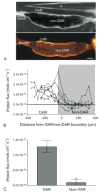Physiological and pharmacological characterizations of the larval Anopheles albimanus rectum support a change in protein distribution and/or function in varying salinities
- PMID: 20460167
- PMCID: PMC2904869
- DOI: 10.1016/j.cbpa.2010.05.002
Physiological and pharmacological characterizations of the larval Anopheles albimanus rectum support a change in protein distribution and/or function in varying salinities
Abstract
Ion regulation is a biological process crucial to the survival of mosquito larvae and a major organ responsible for this regulation is the rectum. The recta of anopheline larvae are distinct from other subfamilies of mosquitoes in several ways, yet have not yet been characterized extensively. Here we characterize the two major cell types of the anopheline rectum, DAR and non-DAR cells, using histological, physiological, and pharmacological analyses. Proton flux was measured at the basal membrane of 2%- and 50%-artificial sea water-reared An. albimanus larvae using self-referencing ion-selective microelectrodes, and the two cell types were found to differ in basal membrane proton flux. Additionally, differences in the response of that flux to pharmacological inhibitors in larvae reared in 2% versus 50% ASW indicate changes in protein function between the two rearing conditions. Finally, histological analyses suggest that the non-DAR cells are structurally suited for mediating ion transport. These data support a model of rectal ion regulation in which the non-DAR cells have a resorptive function in freshwater-reared larvae and a secretive function in saline water-reared larvae. In this way, anopheline larvae may adapt to varying salinities.
Copyright (c) 2010 Elsevier Inc. All rights reserved.
Figures




Similar articles
-
Dose and developmental responses of Anopheles merus larvae to salinity.J Exp Biol. 2013 Sep 15;216(Pt 18):3433-41. doi: 10.1242/jeb.087189. J Exp Biol. 2013. PMID: 23966587 Free PMC article.
-
Larval anopheline mosquito recta exhibit a dramatic change in localization patterns of ion transport proteins in response to shifting salinity: a comparison between anopheline and culicine larvae.J Exp Biol. 2008 Oct;211(Pt 19):3067-76. doi: 10.1242/jeb.019299. J Exp Biol. 2008. PMID: 18805805 Free PMC article.
-
Tissue-specific ionomotive enzyme activity and K+ reabsorption reveal the rectum as an important ionoregulatory organ in larval Chironomus riparius exposed to varying salinity.J Exp Biol. 2013 Oct 1;216(Pt 19):3637-48. doi: 10.1242/jeb.089219. Epub 2013 Jun 20. J Exp Biol. 2013. PMID: 23788699
-
Changing salinity induces alterations in hemolymph ion concentrations and Na+ and Cl- transport kinetics of the anal papillae in the larval mosquito, Aedes aegypti.J Exp Biol. 2007 Mar;210(Pt 6):983-92. doi: 10.1242/jeb.02732. J Exp Biol. 2007. PMID: 17337711
-
Ammonia transport in the excretory system of mosquito larvae (Aedes aegypti): Rh protein expression and the transcriptome of the rectum.Comp Biochem Physiol A Mol Integr Physiol. 2024 Aug;294:111649. doi: 10.1016/j.cbpa.2024.111649. Epub 2024 Apr 24. Comp Biochem Physiol A Mol Integr Physiol. 2024. PMID: 38670480
Cited by
-
Dose and developmental responses of Anopheles merus larvae to salinity.J Exp Biol. 2013 Sep 15;216(Pt 18):3433-41. doi: 10.1242/jeb.087189. J Exp Biol. 2013. PMID: 23966587 Free PMC article.
-
Transcriptomic differences between euryhaline and stenohaline malaria vector sibling species in response to salinity stress.Mol Ecol. 2016 May;25(10):2210-25. doi: 10.1111/mec.13609. Epub 2016 Mar 31. Mol Ecol. 2016. PMID: 26945667 Free PMC article.
-
Toxicological perspective on the osmoregulation and ionoregulation physiology of major ions by freshwater animals: Teleost fish, crustacea, aquatic insects, and Mollusca.Environ Toxicol Chem. 2017 Mar;36(3):576-600. doi: 10.1002/etc.3676. Epub 2016 Dec 30. Environ Toxicol Chem. 2017. PMID: 27808448 Free PMC article. Review.
-
Genome-wide QTL mapping of saltwater tolerance in sibling species of Anopheles (malaria vector) mosquitoes.Heredity (Edinb). 2015 Nov;115(5):471-9. doi: 10.1038/hdy.2015.39. Epub 2015 Apr 29. Heredity (Edinb). 2015. PMID: 25920668 Free PMC article.
-
Proton-driven sodium secretion in a saline water animal.Sci Rep. 2024 Jun 3;14(1):12738. doi: 10.1038/s41598-024-62974-4. Sci Rep. 2024. PMID: 38830894 Free PMC article.
References
-
- Beyenbach KW. Mechanism and regulation of electrolyte transport in Malpighian tubules. J Insect Physiol. 1995;4:197–207.
-
- Boron WF. Sodium-coupled bicarbonate transporters. JOP. 2001;2:176–181. - PubMed
-
- Bradley TJ. Evidence for hypo- and hyperosmotic regulation in the larvae of an anopheline mosquito. Am Zool. 1987a;27(4):30A.
-
- Bradley TJ. Physiology of osmoregulation in mosquitoes. Annu Rev Entomol. 1987b;32:439–462. - PubMed
-
- Bradley TJ. The role of physiological capacity, morphology, and phylogeny in determining habitat use in mosquitoes. In: Wainwright PC, Reilly SM, editors. Ecological Morphology. The University of Chicago Press; Chicago and London: 1994. pp. 303–318.
Publication types
MeSH terms
Substances
Grants and funding
LinkOut - more resources
Full Text Sources

